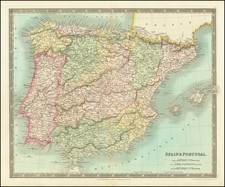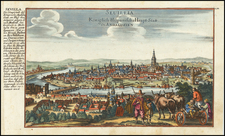Detailed plan of the Battle of Almansa.
The Battle of Almansa, fought on Apirl 25, 1707, was one of the most decisive engagements of the War of the Spanish Succession. At Almansa, the Franco-Spanish army under Berwick soundly defeated the allied forces of Portugal, Britain, and the United Provinces led by the Earl of Galway, reclaiming most of eastern Spain for the Bourbons.
The Bourbon army of about 25,000 was composed of Spanish and French troops, along with an Irish regiment. Opposing them was a mainly Anglo-Portuguese force with strong Dutch, German, and French Huguenot elements.
The Battle began with an artillery exchange. When Galway committed his reserves to an attack on the Bourbon center, Berwick unleashed a strong force of Franco-Spanish cavalry against the weakened Anglo-Portuguese lines, sweeping away the Portuguese horse. A general rout followed, only the Portuguese infantryheld its line, despited being attacked by the three sides, before surrendering at nightfall. Galway lost 5,000 men killed and 12,000 taken prisoner; of his army of 22,000 only 5,000 escaped to Tortosa.
The battle has been described as "probably the only Battle in history in which the British forces were commanded by a Frenchman, the French by a Briton.
Nicholas de Fer (1646-1720) was the son of a map seller, Antoine de Fer, and grew to be one of the most well-known mapmakers in France in the seventeenth century. He was apprenticed at twelve years old to Louis Spirinx, an engraver. When his father died in 1673, Nicholas helped his mother run the business until 1687, when he became the sole proprietor.
His earliest known work is a map of the Canal of Languedoc in 1669, while some of his earliest engravings are in the revised edition of Methode pour Apprendre Facilement la Geographie (1685). In 1697, he published his first world atlas. Perhaps his most famous map is his wall map of America, published in 1698, with its celebrated beaver scene (engraved by Hendrick van Loon, designed by Nicolas Guerard). After his death in 1720, the business passed to his sons-in-law, Guillaume Danet and Jacques-Francois Benard.










![[Palma, Tenerife, Gomera, Hierro] Isla Canarias 1a. Hoja](https://storage.googleapis.com/raremaps/img/small/79081.jpg)
![[Biscaya] De Zeecusten van Vrancrijck en Biscaijen tuschen Arcachon en de C. de Machicaco](https://storage.googleapis.com/raremaps/img/small/84355.jpg)
![[ Galicia ] Die Zee Custen van Galissien, van Capo Daviles off tot Ortegal . . .](https://storage.googleapis.com/raremaps/img/small/39921.jpg)
![[ Spain & Portugal ] Tabula II Europae (Title on Verso)](https://storage.googleapis.com/raremaps/img/small/103197.jpg)
